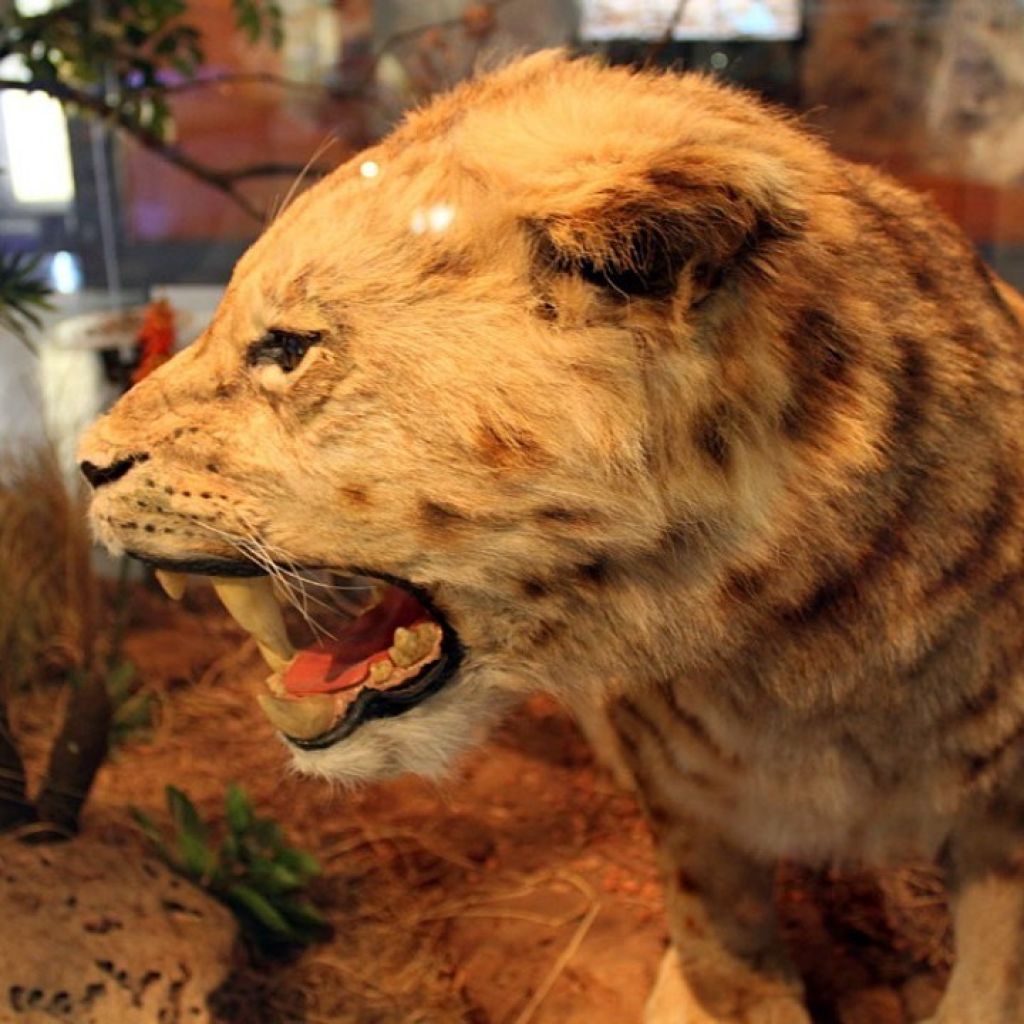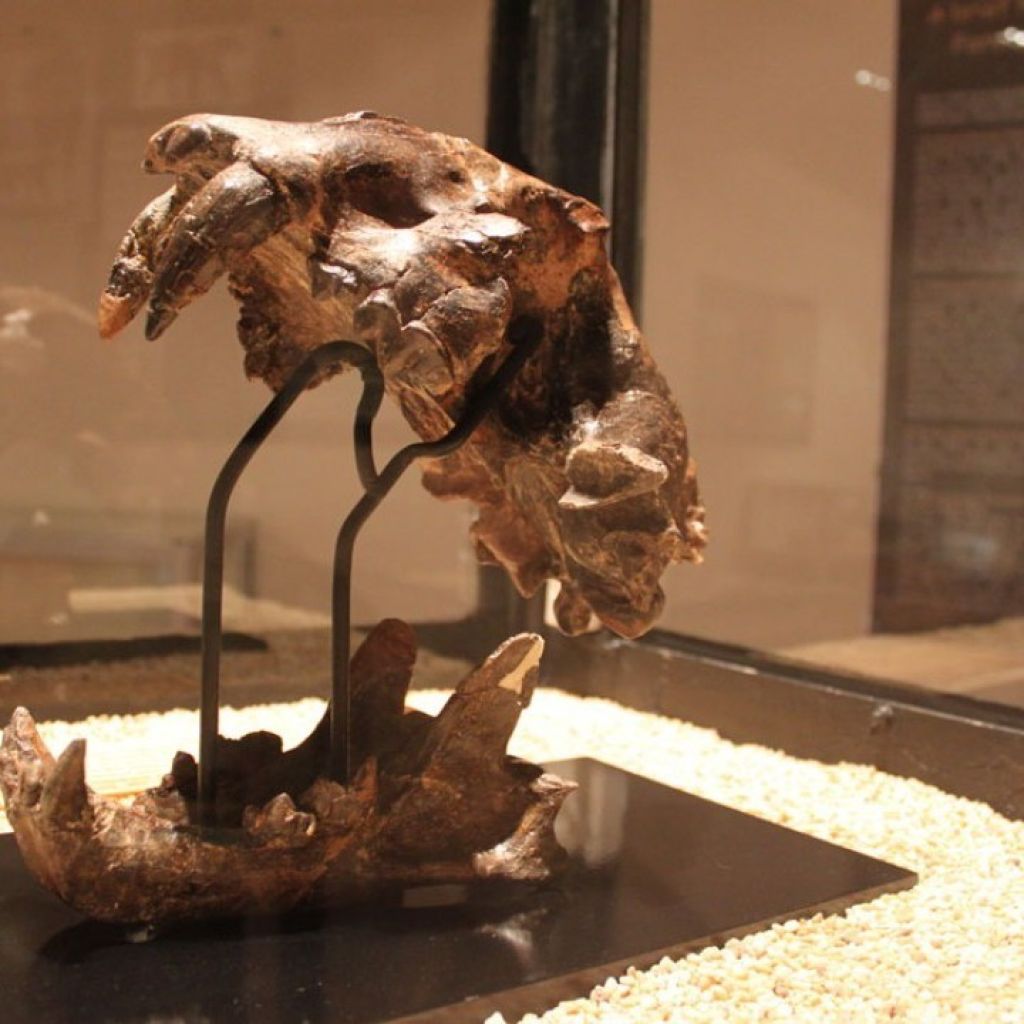Dinofelis – hominid hunter or misunderstood feline?

Modern day cats vary from the cute domestic variety that lounges around the house, to the gigantic tigers that roam Siberia. In the days of our hominid ancestors, the variety was just as diverse.
Millions of years ago, the sabre-toothed cats of the genus Dinofelis (the “terrible cat”), roamed areas in the Cradle of Humankind like Bolt’s Farm and Swartkrans near the Sterkfontein Caves, north west of Johannesburg.
What were the dynamics between hominids and these large cats? How did the two interact with each other? Scientists have been searching for the answer.
Did Dinofelis prey on hominids?
The idea of sabre-toothed cats as hominid predators continues to be explored, but it is likely they were among several creatures hunting our early ancestors. These hominid ancestors included species like Australopithecus africanus and their cousins, Paranthropus robustus.
Palaeontologist Professor Bob Brain did extensive research at Swartkrans where the hominid species Homo ergaster and Paranthropus robustus lived and where Dinofelis remains have also been found.
In his book, The Hunters or the Hunted? An Introduction to African Cave Taphonomy (1981), Brain hypothesises that early humans were the prey of various predators including sabre-toothed cats, and that Dinofelis was a “specialist primate killer”, selecting hominids and baboons as prey.
Brain suggests hominids were vulnerable as they lived in open grassland, and would have sought shelter in cave entrances. This is where sabre-toothed cats like Dinofelis would attack them, dragging them deeper into the caves to devour them.
“Dinofelis dentition was much like a cheetah’s and designed to slice flesh off the carcass,” Brain explained in an interview. “So it could not crunch the bone and much of the skeleton would remain for scavengers like hyenas. Dinofelis would leave behind more than a leopard would, for instance.”
While some time has passed since the publication of his groundbreaking book, Brain still believes it is highly likely that Dinofelis and other sabre-toothed cats were feasting on hominids at Swartkrans.

The secrets are in the teeth
But a study published in the Journal of Human Evolution (Dec 2000, Volume 39, Issue 6, Pages 565 - 576) appears to exonerate Dinofelis, following the analysis of fossil tooth enamel.
Instead, it seems the sabre-toothed cat Megantereon was the culprit preying on hominids in the Swartkrans 2.5-million years ago, among other predators.
Palaeontologist Professor Francis Thackeray, working for the then Transvaal Museum in Pretoria (now the Ditsong National Museum of Natural History), and archaeologists Julia Lee-Thorp and Nikolaas van der Merwe from the University of Cape Town, analysed the chemical composition of tooth enamel from predators and hominids found at Swartkrans.
Included were leopard, lion and spotted hyenas, as well as Dinofelis, Megantereon and Chasmaporthetes, an extinct hyena. They also analysed tooth enamel from Homo ergaster and Paranthropus robustus.
Of interest was the tiny carbon content of each tooth – the carbon isotopes and their ratios to one another, which determine a creature’s diet.
The carbon isotope ratios of prey are mirrored in their predators, and it was discovered that Megantereon, as well as leopards and spotted hyenas, had a taste for hominids.
The carbon isotope ratios of Dinofelis, on the other hand, imply that it fed on grazers like antelope.
The curator of collections at the Ditsong National Museum of Natural History, Stephany Potze, says while many Dinofelis fossil remains have been found at Bolt’s Farm, they have discovered no evidence of predatory behaviour in Dinofelis.
She points out that other animal fossils are often found together with carnivore remains. “[But] we have no tooth marks on these bones that can be assigned to Dinofelis specifically,” she says. “It is also possible that Dinofelis could form part of a faunal deposit as a result of it falling into a cavern and being trapped, or even that it was prey to another carnivores.”
The mystery remains unsolved as to whether Dinofelis was a hominid hunter or not but you can see a well-preserved Dinofelis skull at the Kingdom of the Big Cats fossil display at Maropeng until February 2012.
More facts about Dinofelis
Dinofelis was a creature similar to the jaguar of South America, and between a lion and a leopard in size. Its distinguishing feature, other than its huge fangs, was its powerful front legs, presumably used to pin down its prey ripping into it.
It is also known as a “false sabre-tooth” compared to other kinds of sabre-toothed creatures, because its teeth were not as knife-like, and were more like those of modern-day cats.
One of the most exciting discoveries was the 1947 to 1948 excavation at Bolt’s Farm of three, well preserved skeletons – a male, a female and a youngster, together with the remains of baboons. It was thought the baboons fell into a pit, followed by the feline family.
Dinofelis remains have also frequently been found in caves, together with the bones of their animal prey, giving rise to the idea that they may have been cave dwellers.
Palaeontologists believe that, due to its heavy build, the Dinofelis was not a fast animal. It would therefore have relied on its excellent night vision and stealth to stalk and ambush its prey, hauling it back to its lair.
This prehistoric carnivore has also been discovered in Asia, Europe and North America and lived between 5-million and 1.4-million years ago.
Because there are no remains of skin or soft tissue, no-one knows for sure what Dinofelis’ coat looked like, which is why you see different artists’ impressions. In Africa, Dinofelis is often portrayed as having spots, like a leopard or cheetah.
Further reading:
Studying fossils and extinct animals, Maropeng Exhibition Guide
Bolt’s Farm – the ‘Kingdom of the Big Cats’
The Kingdom of the Big Cats fossil display – photo essay
Chemistry and Hominid Fossils: How to extract information about diet from those ancient teeth and bones, by Julia Lee-Thorp